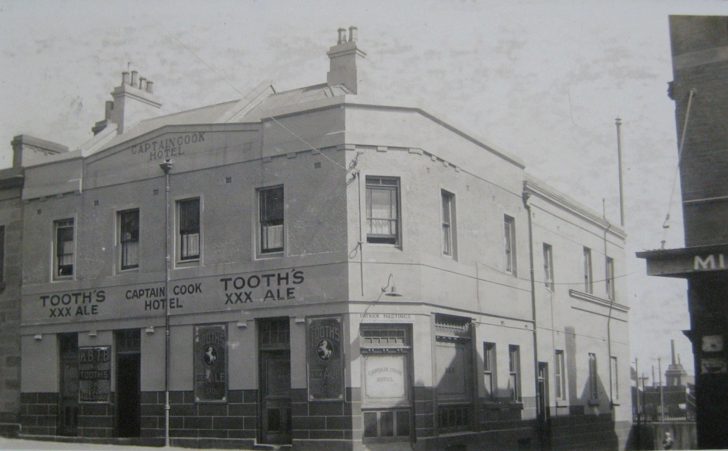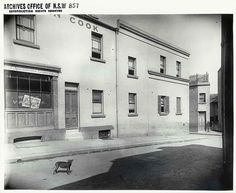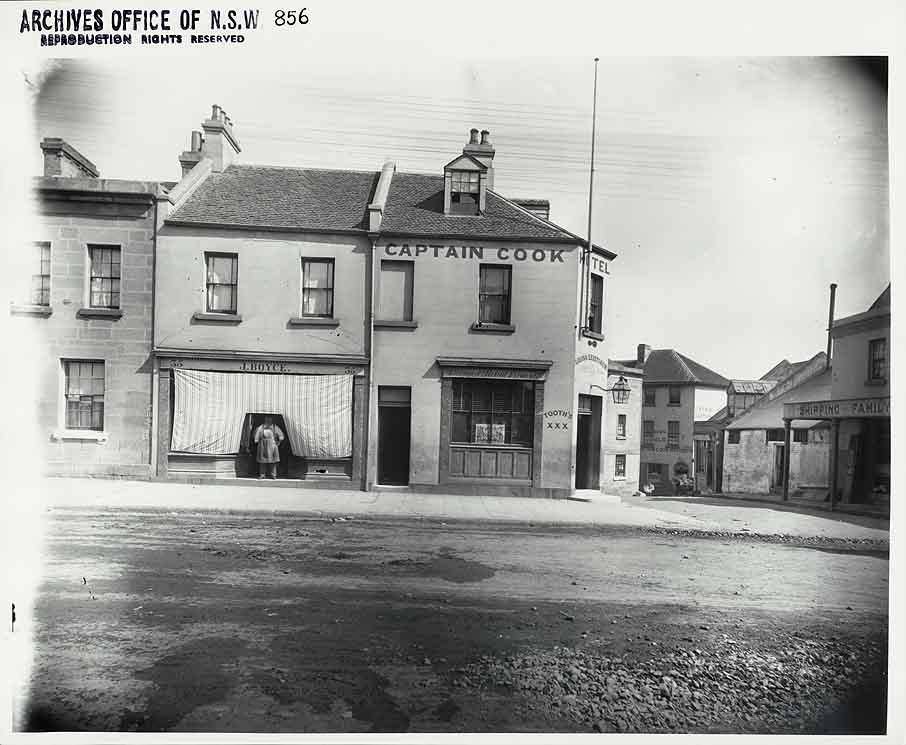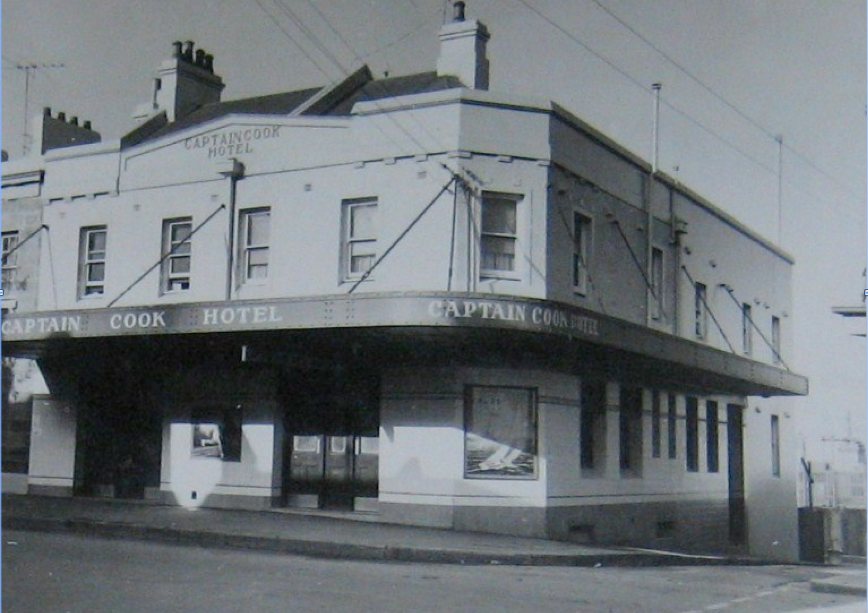History
Captain Cook Hotel
Over the past 142 years, the historical Captain Cook Hotel has proudly opened its doors to the Millers Point community.
Built by local landlord Benjamin Lowe and run by publican William Boyd in 1874, the hotel undertook the name ‘Captain Cook’ to reflect Sydney’s maritime and military past, joining similarly named Millers Point pubs such as the Lord Nelson, the Hero of Waterloo, the Whalers Arms, the Shipwrights Arms, and the Steam Packet. The new hotel joined an 18-strong collective of established pubs in the area providing welcome relief to the wharf workers and ships crews who toiled on the waterfront nearby. The hotel’s six upstairs bedrooms provided accommodation for the publican’s family as well as lodgers and local workers, while the downstairs bar and parlours become popular for public speaking during elections, as meeting places for local organisations, and even by the local coroner who held public enquiries into suspicious deaths.
Over time Captain Cook Hotel has undergone significant renovations changing its look and layout, while retaining its simple late Victorian hotel design and its signature diagonal door on the corner of Kent Street and High Lane. It’s first major renovation was in 1900, which saw the bar extended to the neighbouring shop joining the two buildings together.
The First World War changed Australia’s drinking culture with the introduction of mandatory 6pm closure of pubs in 1916, in an attempt to improve public morality. However the new law only caused what became locally known as the ‘six o'clock swill’ – a last minute rush to buy drinks before bars closed. With the 6pm lockout in full force in 1920, Captain Cook’s bar area was no longer big enough to accommodate the swell of drinkers at the day’s end. As such the hotel was reconfigured under new management from Tooth & Co.
Four front hotel rooms were removed to make way for a large island bar, double doors facing Kent Street were installed, and new toilets, a kitchen, and balcony were also built at the rear, along with a new front façade to cover up the 1870s building with a new modern look. By 1928, only six pubs originally built in the 1870s remained and of those only three - the Captain Cook, the Lord Nelson, and the Hero of Waterloo, survived on their original sites and in their original buildings. 1940 saw another major renovation with the island bar extended further, new windows and rear wing kitchen installed, the dining room fitted out, and a cool room built into the cellar. The front façade was retiled and repainted by Tooth & Co’s company artists. Carpet was laid inside in 1960 after Tooth & Co’s sold the lease to Millers Brewery who took down the old painted signs leaving the outside walls bare. In 1967, Millers sold their entire brewing and hotel business to Toohey’s.
While standing strong for more than a century, the Captain Cook Hotel almost didn’t survive its first five years; the building was nearly lost to a fire in 1878. A servant girl living up stairs, using a candle to light her way to bed, placed it in a box on the landing, not noticing some dresses were hanging above which attracted the flame and ignited. Luckily however some policemen were passing by and were able to extinguish the fire quickly.
Millers Point
Millers Point is one of Sydney’s oldest suburbs. Prior to white settlement, the Cadigal Aboriginal tribe occupied the area for thousands of years. After European settlement in 1788, Millers Point’s exposed shoreline proved the ideal location for windmills. Ex-convict John “Jack the miller” Leighton ran three wooden mills at the head of Cockle Bay’s waterfront. The area became known as Jack the Miller’s Point – or later, just Millers Point.
Throughout the 1830s the village prospered through local industries, shipyards, wharves, and warehouses. By the 1850s gold rush, Millers Point had become Sydney’s maritime heart and was set for a long economic boom.
The turn of the century saw the introduction of the bubonic plague in Sydney, carried by rats that arrived in ships. The state government took control of the waterfront including Millers Point, claiming it must be cleaned up; it has owned and administered the suburb since. Homes were built for waterfront workers, forming Australia’s first public housing.
Millers Point’s wharves were vital in both World War I and World War II, with shipping increased as military equipment and personnel passed through its port.
The 1980s saw Sydney undertake an urban renewal approach to public planning, revamping Darling Harbour and The Rocks as tourism destinations. Wharf activity declined as Port Botany grew. In 1999, the state government passed enabling legislation to redevelop much of the area paving the way for the wharves between Dawes Point and Millers Point to become Walsh Bay.
Sydney Harbour's life as a working port ended in 2003 with the announcement by the Carr government that the historic wharves adjacent to Millers Point would be turned into a new urban precinct – Barangaroo. The same year, the Millers Point and Dawes Point village precinct was listed on the state heritage register.
In 2014, the O’Farrell government announced plans to sell off almost 300 public housing properties at Millers Point, The Rocks, and Gloucester Street with the existing tenants to be relocated. The announcement was marked by strong criticism from residents, Sydney Lord Mayor Clover Moore, and Sydney MP Alex Greenwich. The fight to save Millers Point’s public housing and community is ongoing.
To this day, Millers Point is a significant and historical suburb enriched and fundamentally entrenched with Sydney’s past.
LICENSEES
1874-85 William Bond
1886-87 John Craig
1888-89 Louisa Leistikow
1889-90 Bridgit Corcoran: charged with Sunday trading in July 1889
1891 Richard Page (married Bridgit Corcoran): license cancelled after accommodation found to beinsufficient
1892-98 Christopher Cullen
1899-00 Alfred Bird
1901-02 Sarah Bird: Sarah took over the license after her husband Alfred died in 1900
1903-16 Edward Brown
1917 Harvey Taft
1918-20 Thomas Brice
1921-29 Arnold Hayes
1930-33 Patrick Hastings
1934-39 Elsie Hastings
1940 Seth Jenkins
1940 Charles Loaney
1942-46 Leslie Upjohn
1946-49 Patrick Homan
1951-52 Rose McCulloch
1952-55 Mary O’Keefe
1955 Allan Mackenzie
1956-58 Edwin Samuel
1959 James Noel
1960-61 Thomas Carroll
1962-66 Joseph Fish
1966 William Collins
1967 Leslie Heggarty
1968 Donald Chater
1969-70 Keith Parsonage
1971 Richard McMahon
1972-73 Donald Wallace
1974-78 Gloria Mccarron
1978 Leslie Heggarty
1979 Gloria McCarron
1986 John Balzer
2003 Kevin Chen Chow
Historical Images from
City of Sydney Archives
State Library NSW
Museum Victoria
City of Sydney Image Library





